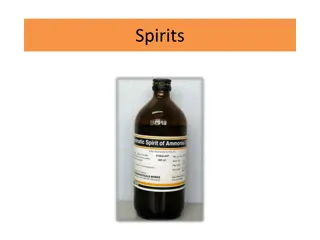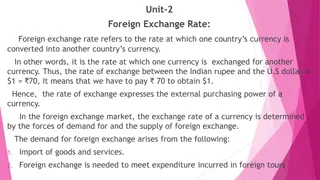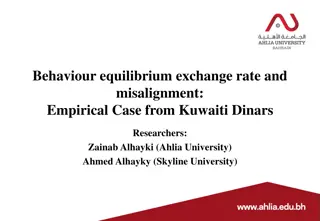Understanding Solutions: Definitions, Types, and Rate of Dissolving
Solutions are homogeneous mixtures of solutes dissolved in solvents. They can be saturated, unsaturated, or supersaturated based on solubility. The process of dissolving involves solvation, and factors like stirring, particle size, and temperature affect the rate of dissolving.
Download Presentation

Please find below an Image/Link to download the presentation.
The content on the website is provided AS IS for your information and personal use only. It may not be sold, licensed, or shared on other websites without obtaining consent from the author. Download presentation by click this link. If you encounter any issues during the download, it is possible that the publisher has removed the file from their server.
E N D
Presentation Transcript
Ch. 8 Solutions, Acids, & Bases I. How Solutions Form Definitions Types of Solutions Dissolving Rate of Dissolving
A. Definitions Solution a mixture that has the same composition throughout the mixture; a homogeneous mixture. Solute - substance being dissolved (in lesser quantity) Solvent what the solute is dissolved in (in greater quantity)
A. Definitions Solute - KMnO4 Solvent - H2O
Solutions Solution a mixture that has the same composition throughout the mix. Remember the difference between a mixture and a compound. Compounds have a fixed composition throughout. Mixtures can have a variable composition throughout.
A. Definitions Solubility The maximum amount of solute that can be dissolved in the solvent at a given temperature.
B. Types of Solutions Saturated solutions maximum amount of solute at a given temperature. Unsaturated solutions less than the maximum amount of solute at a given temperature.
Supersaturated solutions more than the maximum amount of solute at a given temperature; unstable.
B. Types of Solutions UNSATURATED SOLUTION more solute dissolves SATURATED SOLUTION no more solute dissolves SUPERSATURATED SOLUTION becomes unstable, crystals form concentration
C. Dissolving Solvation occurs at the surface of the solute solvent particles surround solute particles (+/- attraction) solute particles are pulled into solution
D. Rate of Dissolving Solids dissolve faster... more stirring small particle size (increased surface area) high temperature
Rate of Dissolving To increase rate of dissolving of SOLIDS: Heat it Crush it Stir it
D. Rate of Dissolving Gases dissolve faster... no shaking or stirring high pressure low temperature
To make a gas dissolve more quickly in a liquid: Cool it Increase the pressure of the gas
Ch. 8 Solutions, Acids, & Bases II. Concentration & Solubility
A. Concentration % by Volume usually liquid in liquid Ex: 10% juice = 10mL juice + 90mL water % by Mass usually solid in liquid Ex: 20% NaCl = 20g NaCl + 80g water
A. Concentration Concentrated solution large amount of solute Dilute solution small amount of solute
B. Solubility Solubility maximum grams of solute that will dissolve in 100 g of solvent at a given temperature varies with temperature based on a saturated solution
B. Solubility Solids are more soluble at... high temperatures Gases are more soluble at... low temperatures high pressures (Henry s Law)
C. Solubility Charts Reading Solubility Charts If the number in the problem is EQUAL to the value on the chart the solution is considered SATURATED If the number in the problem is LESS than the value on the chart the solution is considered UNSATURATED If the number in the problem is MORE than the value on the chart the solution is considered SUPER SATURATED
C. Solubility Charts Solubility of Compounds in g/100g of Water at various Temperatures Compound 0 C 20 C 60 C 100 C Ammonium chloride Copper(II) sulfate Lead(II)chloride Potassium bromide Sodium chlorate 29.4 23.1 0.67 53.6 79.6 37.2 32.0 1.0 65.3 95.9 55.3 61.8 1.94 85.5 137 77.3 114 3.2 104 204
Answer Questions on your paper Chart 1) How would you classify a solution of 65.3g of potassium bromide at 20 C? _________ 2) How would you classify a solution of 65.3g of potassium bromide at 60 C? ____________ 3) How would you classify a solution of 65.3g of potassium bromide at 0 C? ______________ 4) How would you classify a solution of 37g of ammonium chloride at 20 C? ___________ 5) How would you classify a solution of 2.5 g of lead (II) chloride at 20 C? ______________ Saturated Unsaturated Supersaturated Unsaturated Supersaturated
D. Solubility Graphs Solubility Curve shows the dependence of solubility on temperature
Graph 6) How would you classify a solution of 80g of HCl at 20 C? ____________ 7) How would you classify a solution of 30g of KNO3 at 20 C? __________ 8) How would you classify a solution of 39g of NaCl at 100 C? ________ 9) How would you classify a solution of 80g of NaNO3 at 30 C? __________ 10)How would you classify a solution of 40g of KClO3 at 80 C? __________ Unsaturated Supersaturated Unsaturated Saturated Unsaturated
11)How many grams of solute would you need to form a saturated solution of NH4Cl at 50 C? _____ 12)How would you classify a solution of 20g of SO2 at 0 C? ___________ 13)How much KI would you need to form a saturated solution at 10 C? _____ 14)Which solid decreases in solubility as the temperature increases? _______ 50 g Unsaturated 135 g Na2SO4
Acid, Bases & Salt Video Pre Test 1. True 2. False 3. True 4. True 5. False 6. False 7. True 8. True 9. False 10. False Post Test 1. Neutralization 2. Base 3. Anion 4. Electrolytes 5. False 6. False 7. True 8. False 9. False Post Test 10. bitter, slippery, high pH 11. Acids donate hydrogen, Bases accept Hydrogen 12. An easy way to gauge is something is a strong/weak acid or base
Ch. 8 Solutions, Acids, & Bases III. Particles in Solution Like Dissolves Like Electrolytes
A. Like Dissolves Like Polar substances will only dissolve in polar liquids Rubbing alcohol and water Nonpolar substances will only dissolve in nonpolar liquids Oil and butter Substances that aren t the same don t mix. Oil and water
A. Like Dissolves Like NONPOLAR POLAR NONPOLAR POLAR Detergents polar head with long nonpolar tail can dissolve both types (polar and nonpolar)
B. Electrolyte An electrolyte is a substance that when dissolved in water form ions Electrolytes get their name from the fact that the conduct electricity in water. Example: salt dissolved in water Many sports drinks contain electrolytes which are salts dissolved in water
B. Electrolytes - - - + + + salt acetic acid sugar Weak Electrolyte solute exists as ions and Molecules Slightly conducts electricity Non- Electrolyte solute exists as ions only Easily conducts electricity Electrolyte solute exists as molecules only Does NOT conduct electricity
B. Electrolytes Dissociation separation of +/- ions when an ionic compound dissolves in water
B. Electrolytes Ionization breaking apart of polar covalent molecules into ions when dissolving in water
Ch. 8 Solutions, Acids, & Bases IV. Intro to Acids & Bases Definitions Properties Uses
A. Acids Acids contain at least one hydrogen atom that can be removed when the acid is dissolved in water. These form hydronium ions, H3O+. Also called a proton donor HCl + H2O H3O+ + Cl
A. Bases Bases form hydroxide ions (OH-) in a water solution. a proton acceptor NH3 + H2O NH4+ + OH-
A. Indicators Indicators are an organic substance that changes color in an acid or base. Examples: litmus - red/blue phenolphthalein - colorless/pink goldenrod - yellow/red red cabbage juice - pink/green
B. Properties ACIDS BASES bitter taste sour taste pH greater than 7 pH less than 7 corrosive corrosive electrolytes electrolytes turn litmus blue turn litmus red slippery feel react with metals to form H2 gas
C. Uses ACIDS H3PO4 phosphoric acid - soft drinks, fertilizer, detergents H2SO4 sulfuric acid - fertilizer, car batteries HCl hydrochloric acid - gastric juice HC2H3O2 acetic acid - vinegar
C. Uses BASES NaOH sodium hydroxide -lye, drain and oven cleaner Mg(OH)2 magnesium hydroxide - laxative, antacid NH3 ammonia - cleaners, fertilizer
Ch. 8 Solutions, Acids, & Bases V. Strength of Acids & Bases Strength vs. Concentration Strong vs. Weak pH
A. Strength vs. Concentration Strong and weak tells how easy the acid or base dissociates in solution. Concentration The amount of acid or base in a solution. It is possible to have a dilute concentration of a strong acid that would be less harmful than a concentrated weak acid.
A. Strength of Acids & Bases The strength of an acid or base depends on how completely a compound separates into ions when dissolved in water. Ions can carry an electric charge so a strong acid will carry more electricity than weak acid.
B. Strong vs. Weak - Strong Acid/Base 100% ions in water strong electrolyte HCl, HNO3, NaOH, LiOH + Weak Acid/Base few ions in water weak electrolyte HC2H3O2, NH3 - +
B. Strong Acids Acids that ionize almost completely in a solution are strong acids. Ex: HCl, HNO3, and H2SO4 They have a very low pH (0-1).
B. Strong Bases Bases that dissociate completely in a solution are strong bases. Ex: NaOH They have a very high pH (13-14)
C. pH Scale pH (potential of Hydrogen) a measure of the concentration of H+ ions in a solution measured with a pH meter or an indicator with a wide color range (0-14) 14 0 7 INCREASING BASICITY INCREASING ACIDITY NEUTRAL
C. pH Scale pH of Common Substances
ConcepTest Which of the following "molecular" pictures best represents a concentrated solution of the weak acid HA? A B
ConcepTest Is the following statement TRUE or FALSE? A strong acid has a lower pH than a weak acid. True- But: Strong/weak refers to amount of ionization whereas pH refers to concentration of H+.
Ch. 8 Solutions, Acids, & Bases VI. Neutralization Neutralization Reaction























